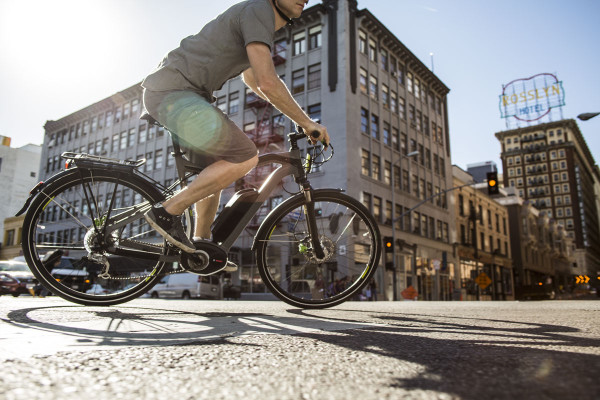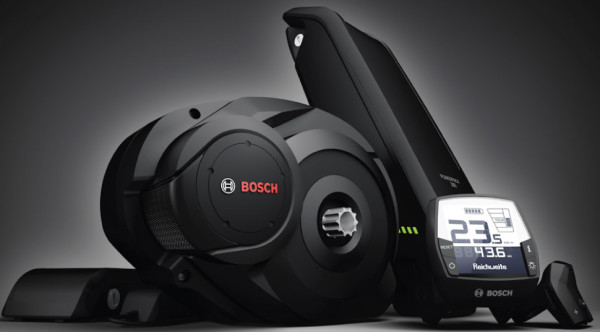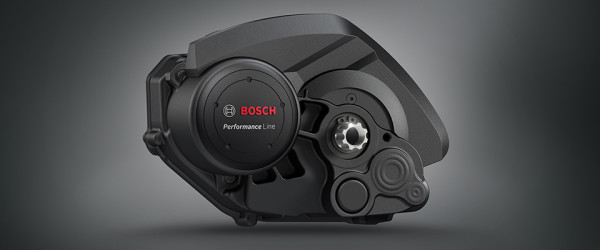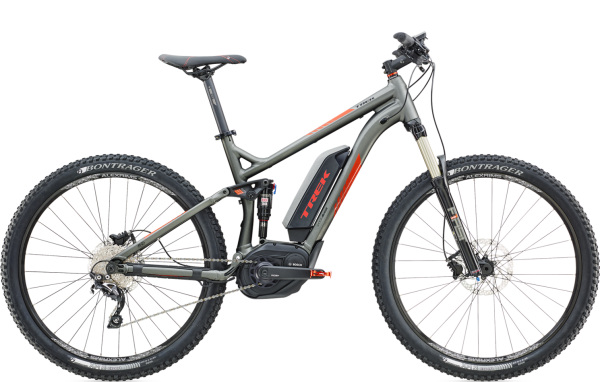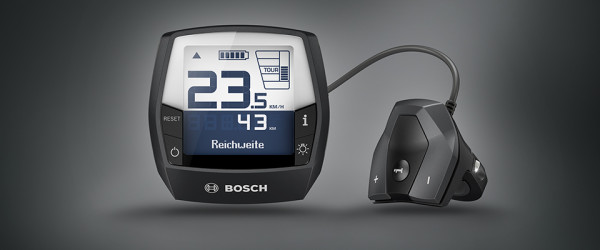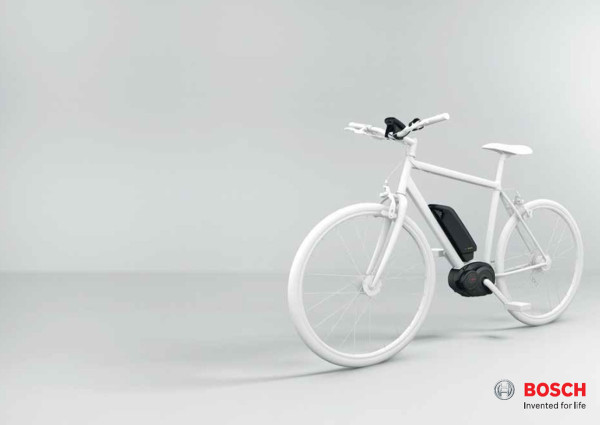Bosch, after only beginning its eBike technological journey in 2009, has released a refined and improved electric system in their eBike Performance Line. The battery lasts longer. The Drive Unit now comes in multiple flavors to better integrate with the bicycle frame as a static chassis and in motion under different types of riders. The sophisticated controls are highly integrated on a level you don’t often see in the product of this industry and are highly user focused from a conscious and unconscious interactive standpoint. There is a reason why it won the Red Dot award for design excellence.
Let’s dig into this new system after the jump…
Opinion – eBike Technology is worth a look:
The frustrating thing about the conversation surrounding eBikes in the US is that it is so overwhelmingly negative for political or emotional reasons. As an appreciator of bike technology and design, I think it’s important to go deep into new products to understand the opportunities that technology presents. It is disrespectful to the technology and, frankly, ignorant to completely dismiss or disregard that technology because at first glance it rubs you the wrong way. Hating on something is easy. Understanding it takes thought and consideration.
For eBikes specifically: they may not be your bag, and no one is telling you they should be. You may perceive them to represent a threat to your current way of riding and ride experience. But the threat of change is everywhere. The context of technology is constantly changing and change is really the only constant in our industry. Your personal context of riding is constantly changing as you grow or lose strength or flexibility and as new technology is developed, refined, or comes into vogue.
You don’t have to love a technology for yourself, but when you put it into that larger contextual framework you can appreciate and respect it within its place in the evolutionary timeline. It’s why looking back on older product is so fascinating. You find that the most polarizing technology in retrospect is the most interesting – the product of the industry either adapts to it, adopts aspects of it, or reacts against it. It’s all part of our product ecosystem. It’s healthy. At points carbon fiber, fat tires, suspension, and electronic shifting were each supposed to burn the industry house down… but the house is still standing. Heck, it’s enhanced by the diversity of dialogue that those technologies have contributed.
So within that context, let’s sit back a minute and talk about an example within an emerging technology that is currently impacting our product ecosystem and the opportunities its advancements present.
First and foremost, the new Bosch Performance Line ebike system overall seeks to join the rider/bicycle experience as a harmonious player, seeking to enhance the activity of pedaling rather than as an additive aspect of the experience. While there is a walk assist function in the controls, there isn’t a throttle- it isn’t a “scooter.” The controls are designed to support each pedal stroke as an active rider, sampling data to the tune of 1000 readings a second from your power, cadence, and speed- reading the state of your body and of the machine in motion together to smoothly change the assist and gearing from within the motor.
The Drive Unit Performance comes in several flavors, each designed with gear change detection technology for rear derailleur configuration. Performance Cruise, 250W which tops out at 25km/h (~15.5mph) and Performance Speed, 350W which tops out at 45km/h (~28mph) share a body style, a high output torque of 60Nm, and weigh in at under 4kg (~8.8lbs), according to Bosch.
New and exciting for Spring is the Performance CX Drive Unit, where Bosch managed to shave 200g off the robust aluminum body style and modified the overall body to have more clearance and a better overall shape for integration into mountain suspension designs. They have also introduced this model with a tough matte black powdercoat finish for in-field resilience and to better visually interface with modern mountain product styling. This Drive Unit has already begun to appear on production models such as the Trek Powerfly + FS (available only in Europe).
The Lithium Ion battery pack is easily removable if you want to take it with you to charge or to prevent tampering or theft, can be charged on or off the bike, and is specifically designed to be resistant to overloading, undervoltage, overheating, and short-circuiting for a long operating life. The Performance line has two battery levels, the PowerPack 300 Performance and the slightly larger, nearly one pound heavier PowerPack 400 Performance (300Wh and 400Wh respectively). Both mount to the top of the down tube, but the PowerPack 400 also comes in a rack mounted flavor. Bosch boasts a full recharge on both battery levels after only 2.5 hours and a 50% charge after 1 hour with the PowerPack 300.
Where the active user interaction comes most into play is with the Intuvia computer display system, a feature consistent across the whole Performance line. It’s designed to be extremely intuitive, removable when not in use (again, to deter theft or tampering), and easily adjustable on the bike by the rider for different riding positions or to mitigate glare. Whether or not the drive system is assisting the rider, Intuvia still acts as a typical bike computer with clock, trip time, and speed functions and controls front or rear lights that can be integrated into the eBike system and powered by the battery. It has an independent 3.7v Lithium ion polymer battery that charges off of the system battery pack, but allows the display system to be functional when not installed. Intuvia also includes a USB port so users can recharge their phone or music player while they ride, a nice feature that we expect from modern automobiles so it’s interesting, and I think reasonable, that we see it here.
The Intuvia monochrome display is designed to be super easy to read (in English too) and offers readouts for the five states of power assist (Off 0%, Eco 50%, Tour 120%, Sport 190%, and Turbo 275%) with feedback on your distance range at current charge and power assist state so you don’t run out of juice before you get where you’re going. As opposed to a simple cycle computer, this system features a remote button pad mounts to the handlebar easy access while you have your hands on your grips (a stem cap mount is available for crowded drop bar cockpit scenarios).
This system a whole has the benefit of keeping the majority of the ~15lb of added weight low and center in the frame for added stability as opposed to a hub driven format, which puts more weight over the rear. It keeps your front wheel grounded in a more balanced loading scenario. It does its best to be a harmonious partner working to enhance the rider/bike experience at every interface, whether it is in dynamically adjusting power assist from your pedal stroke input or in making it simple to take your battery and display with your when locking up the bike. It has applications both in the city and in off-road performance, being endorsed by downhill racers such as Sabine Spitz, as a great way of getting back up the mountain without getting burned out when training- and a lot of fun on trails besides.
It has its limitations. While it’s lightweight for what it accomplishes, it’s still an extra fifteen pounds on your bike. Battery life, while improved, remains a limitation, especially under difficult riding conditions. You can ride it at its highest assist level, sure, but not for very long. And you won’t get insane speeds out of the system unless you put the effort in, and even then there is a maximum velocity programmed into the system (a limitation or a design feature depending on who you are with relation to the eBike in question).
But overwhelmingly, this technology, like other technology, intends to give riders a better experience on a bike. It’s undeniably helpful in hilly commuting or in hauling. In an industry dominated by able-bodied people making product for able-bodied consumers, it represents a way for those less able-bodied to continue to participate or enjoy the sport. It allows individuals to ride technical courses faster as they can do things like accelerate out of corners more quickly. Take it for what it is; a cleverly designed, thoughtful system intended to increase the joy of riding your bike.
For more information about this system, and for brands where it is in use, visit Bosch’s website.
